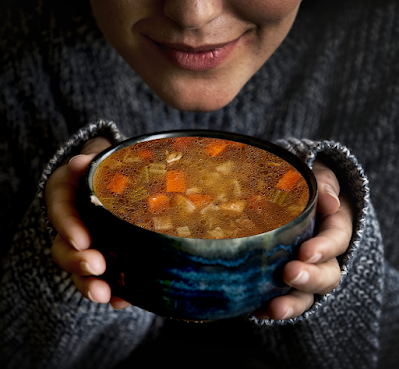When It's Cold Outside
When it’s cold outside how comforting is it
to
sit down to a nice warming bowl of soup?
Do you ever wonder about how long this
flavourful and nutritious food has been around? For
thousands of years humankind has enjoyed the liquid foodstuff known as “soup” Food historians tell us soup is as old as the
history of cooking.
According to
archaeologist John Speth, our ancient Neanderthal relatives were likely to have
begun boiling meat to render fat from animal
bones – resulting in a meat broth that they would have drunk as soup. In Xianrendong Cave, Jiangxi Province, China,
the first example of a soup bowl was discovered and thought to date back to
20,000 BC. Conquering the ancient world for over 500 years, the Roman Empire
had a big impact on the history of ancient soup. Soup makers in medieval Europe
continued to develop soups based on a range of ingredients from meats to
vegetables. In 18th century France, street vendors would sell a soup known as a
‘restoratif
‘. When an enterprising man named Boulanger decided to open a quiet
eatery featuring soups, eggs and other restoratifs, the first restaurant was
born. In 1786, the first luxury restaurant opened in Paris. This led to a trend
of Gastronomique cooking
styles that in turn defined the types of soups we know today.
Soups are broadly
classified into two types- thick and thin, however, there are two more categories
cold and international.
Thin Soups have no thickening agent in them and are made using chicken, beef, fish, or vegetable broth/stock. Thin soups can be full of bold distinct flavours and should never taste watery. Thin soups can be further split into Unpassed and Passed.
- Passed soups sometimes called clear soups as any chunks of ingredients are strained out after preparation and you are left with a just liquid. The specialty of this soup is simple, clear transparent flavourful and without any solid ingredients. Consommé a French clarified meat or fish broth is a classic version of a passed soup.
- Unpassed soups are broths or bouillons, terms which are virtually interchangeable however, broths are a usually a little cloudy while bouillons are clear . A broth is a stock-based soup which is not strained. It is garnished with chopped, herbs, vegetables or meats. Minestrone and Beef Barley are examples of broths. Bouillon comes from the word boil and has a richer more pronounced meaty flavour and is clear with pieces of vegetables, meat, seafood etc. floating in it.
Thick Soups are soups that are thickened
using flour, corn-starch, cream, vegetables, gelatins, and other ingredients. Thick
soups can be further broken down into Puree, Cream, Chowder, Bisque, and Velouté.
- Puree
soups are thick soups made by cooking and then pureeing
vegetables or ingredients used in the soup. For example, lentil soup, butternut
squash, etc. One can roast the vegetables to give a better flavour.
- Cream soups are traditionally a basic roux, thinned with cream or milk and combined with a broth of your preferred ingredient. Cream of Mushroom or Cream of Asparagus are examples
- Chowder is a thick soup made with clams, fish or vegetables thickened with potatoes and finished with cream or milk. Clam Chowder and Corn Chowder being two of the most popular types.
- Bisque is a smooth, creamy French style of soup, traditionally made from crustaceans like lobster, crab or crayfish that is pureed and strained for a smooth result. Bisques are usually thickened with rice, and often topped with a few morsels of the main shellfish ingredient. Lobster Bisque being the most famous bisque.
- Velouté soup is different from a cream soup, as the
base is made by preparing blond roux and stock.
It can be either meat or vegetable based, and when eaten, are a
velvety texture,
Cold Soups as the name implies are soups that are served cold. They are not chilled
as chilling would mute the flavours of the soup. Examples of cold soups would
be jellied consommé, gazpacho, vichyssoise, etc.
International Soups represent the region of origin, like the Cock-a-Leekie from Scotland or Borscht from Poland. They can be hot or cold.
Cold and International soups while often listed as a separate classification of soup they are just descriptive titles. Examples of thin and thick soup could be found in both classifications.
There is nothing better than a nice bowl of freshly made soup.
My next couple of posts will be some of my favourite soup recipes to get you started.





My favourite are cream soups and chowders. I didn’t know the difference before reading this post. I am NOT a fan of cold soups.
ReplyDelete